Air conditioning (AC) may be cooling us, but it’s cooking our planet.
Countries around the world have experienced scorching temperatures this summer. This August was the second hottest on record. Global warming and more intense summer heat waves, coupled with increased urbanisation and rising incomes, are driving a dramatic increase in demand for AC units.
The International Energy Agency (IEA) predicts that the number of ACs in operation globally will increase from 1.6 billion today to 5.6 billion by 2050. Over the next 30 years, ten air conditioners will be sold every second.
Air conditioners contribute significantly to the greenhouse-gas emissions fueling climate change, both directly, owing to the hydrofluorocarbon (HFC)-based refrigerants they contain, and indirectly, given the energy they consume.
“
Over the next 30 years, ten air conditioners will be sold every second.
A recent report by the IEA and the United Nations Environment Program is the latest to highlight the threat, describing it as “one of the most critical and often neglected climate and development issues of our time.”
The 2016 Kigali Amendment to the Montreal Protocol on Substances that Destroy the Ozone Layer aims to reduce HFC production and consumption by over 80 per cent by 2047. If implemented, this could avoid 0.4°C of global warming this century. But while the Kigali Amendment provides a pathway to address refrigerants, the world must now tackle the problem of air conditioners’ energy intensity.
Most AC units sold today are 2-3 times less efficient than the best commercially available products. This is largely because consumers buy the lowest-priced units, with little or no understanding of the lifecycle cost implications of their purchase. The IEA estimates that widely diffusing the most efficient air conditioners on the market today could cut cooling energy demand by half.
While the AC industry needs to continue making units more efficient, we can, and must, take steps to drive the adoption of the best products already available. That means flipping the way we address the efficiency issue, which in turn will require policymakers and the industry to come together and show bold leadership.
One way to boost energy efficiency is through policy intervention, specifically regarding minimum energy-performance standards (MEPS). Currently, MEPS are set just above the level of the worst-performing AC products, in order to keep them out of the market and provide some protection to consumers.
But with market growth continuing to accelerate, policymakers should instead set MEPS with reference to the best commercially available products – meaning that the MEPS would be just below the technology ceiling, rather than just above the technology floor.
This significant change would not only protect consumers; it would also considerably reduce the lifecycle costs of owning and operating air conditioners. At the same time, it would still allow sufficient space for product competition, thereby bringing down the purchase price of more efficient units.
Such a policy could emulate and build on Japan’s Top Runner program, launched in 1999, which effectively advances the country’s AC market while delivering energy savings and reducing lifecycle costs. The scheme encourages consumers to purchase the best-performing available units through a labeling program, which in turn increases economies of scale and lowers costs. And by demanding more efficient AC technologies from the market, Top Runner also bolsters investor confidence.
Targeting maximum efficiency in this way worldwide would decrease the lifecycle cost for consumers of owning an AC unit by a factor of two to three and eliminate the need for over 1,300 gigawatts of electricity generation capacity globally. It would also avoid 157-345 gigatons of carbon dioxide emissions over the next four decades.
Establishing policies based upon the best commercially available AC products rather than the most commonly sold ones would thus avoid emissions, reduce government spending on power generation, and save consumers money, all while continuing to incentivise the market to develop better performing products.
Better yet, such a policy shift would prepare the market for AC products with even greater efficiency potential that are already on the horizon. In 2018, an international coalition launched the Global Cooling Prize to identify a residential room air conditioner that uses dramatically less energy and contains refrigerants with little to no effect on the climate.
Eight teams have developed technologies that potentially could have five times less climate impact than standard AC units on the market today. Following testing this fall, one winner will be awarded a prize of $1 million in March 2021 for their innovative cooling solution.
Scaling such a cooling technology globally could save consumers $1 trillion in operational costs in the next 30 years, and avoid up to 0.5°C of warming by the end of the century. And that includes only the residential sector.
A single change in our approach to energy efficiency can enable more people around the world to stay cool, benefit consumers, and flatten the curve on cooling-related energy demand and emissions. If we want climate-friendly AC, we need to leap toward the technology ceiling.
Iain Campbell is a senior fellow at the Rocky Mountain Institute. Caroline Winslow is an associate with the Buildings Team at the Rocky Mountain Institute.
Copyright: Project Syndicate, 2020.
www.project-syndicate.org










